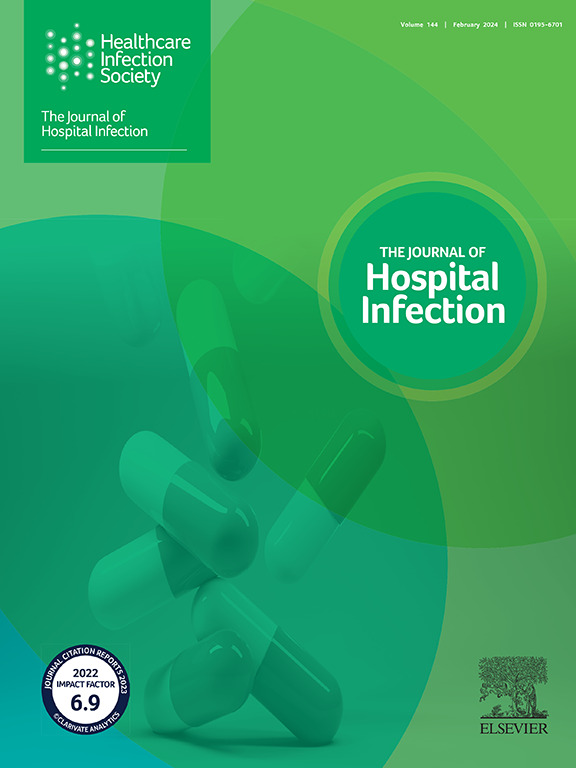Emergence of Mycobacterium gordonae in heater–cooler units: a five-year prospective surveillance of devices frequently subjected to chloramine-T booster disinfection
IF 3.9
3区 医学
Q1 INFECTIOUS DISEASES
引用次数: 0
Abstract
Background
Worldwide, the detection of Mycobacterium chimaera in LivaNova heater–cooler units (HCUs) has led to their replacement with other HCUs, although non-tuberculous mycobacteria (NTM) have been reported also for HCUs produced by other manufacturers. In almost all hospitals of our region, LivaNova HCUs have been replaced with Maquet HCU40s, regularly disinfected with chloramine-T.
Aim
To report the results of the surveillance over a 63-month operation period of the Maquet devices, and to provide a trend in NTM positivity over time.
Methods
Twenty-nine Maquet devices (HCU40 and HU35) were monitored by two culture methods and propidium monoazide polymerase chain reaction (PMA-PCR) method. The trend in NTM positivity rate was evaluated through the Locally Estimated Scatterplot Smoothing regression and then modelled over time through segmented logistic regression.
Findings
The data acquired during the study period demonstrate a remarkable increase in the positivity rate, especially after the third year (maximum slope change at 1280 days). Non-tuberculous mycobacteria were isolated in 150 water samples (37.2%); 100% and 62% of HCU40 and HU35 devices, respectively, were colonized with non-tuberculous mycobacteria. The most frequently detected species were Mycobacterium gordonae (73%) followed by Mycobacterium chelonae (41%) and Mycobacterium paragordonae (11%).
Conclusion
Preventive strategies by disinfection with chloramine-T did not effectively reduce non-tuberculous mycobacteria colonization of Maquet devices. Although, to date, no cases of postoperative invasive infections linked to Maquet devices have been reported, our microbiological results emphasize the need for (1) designing changes to increase safety of devices and (2) researching and developing new disinfection protocols including alternative molecules.
加热器冷却器中出现戈登分枝杆菌:对经常使用氯胺-T 强化消毒的设备进行为期五年的前瞻性监测。
背景:在全球范围内,由于在 LivaNova 加热器-冷却器(HCU)中发现了分枝杆菌,因此已用其他 HCU 取而代之,尽管其他制造商生产的 HCU 中也有非结核分枝杆菌(NTM)的报道。在我们地区的几乎所有医院中,LivaNova HCU 已被 Maquet HCU40 取代,并定期用氯胺酮 T 消毒:采用两种培养方法和 PMA-PCR 方法对 29 台 Maquet 设备(HCU40 和 HU35)进行了监测。通过局部估计散点图平滑回归评估了 NTM 阳性率的趋势,然后通过分段逻辑回归建立了随时间变化的模型:研究期间获得的数据表明,阳性率显著上升,尤其是在第三年之后(1280 天时斜率变化最大)。在 150 份水样(37.2%)中分离出了非结核分枝杆菌;HCU40 和 HU35 设备中分别有 100% 和 62% 滋生了非结核分枝杆菌。最常检测到的菌种是戈登分枝杆菌(73%),其次是螯合分枝杆菌(41%)和副戈登分枝杆菌(11%):结论:使用氯胺-T 消毒的预防策略并不能有效减少 Maquet 设备中的非结核分枝杆菌定植。尽管迄今为止还没有与 Maquet 设备相关的术后侵入性感染病例的报道,但我们的微生物学研究结果强调了以下两方面的必要性:1)改变设计以提高设备的安全性;2)研究和开发包括替代分子在内的新消毒方案。
本文章由计算机程序翻译,如有差异,请以英文原文为准。
求助全文
约1分钟内获得全文
求助全文
来源期刊

Journal of Hospital Infection
医学-传染病学
CiteScore
12.70
自引率
5.80%
发文量
271
审稿时长
19 days
期刊介绍:
The Journal of Hospital Infection is the editorially independent scientific publication of the Healthcare Infection Society. The aim of the Journal is to publish high quality research and information relating to infection prevention and control that is relevant to an international audience.
The Journal welcomes submissions that relate to all aspects of infection prevention and control in healthcare settings. This includes submissions that:
provide new insight into the epidemiology, surveillance, or prevention and control of healthcare-associated infections and antimicrobial resistance in healthcare settings;
provide new insight into cleaning, disinfection and decontamination;
provide new insight into the design of healthcare premises;
describe novel aspects of outbreaks of infection;
throw light on techniques for effective antimicrobial stewardship;
describe novel techniques (laboratory-based or point of care) for the detection of infection or antimicrobial resistance in the healthcare setting, particularly if these can be used to facilitate infection prevention and control;
improve understanding of the motivations of safe healthcare behaviour, or describe techniques for achieving behavioural and cultural change;
improve understanding of the use of IT systems in infection surveillance and prevention and control.
 求助内容:
求助内容: 应助结果提醒方式:
应助结果提醒方式:


